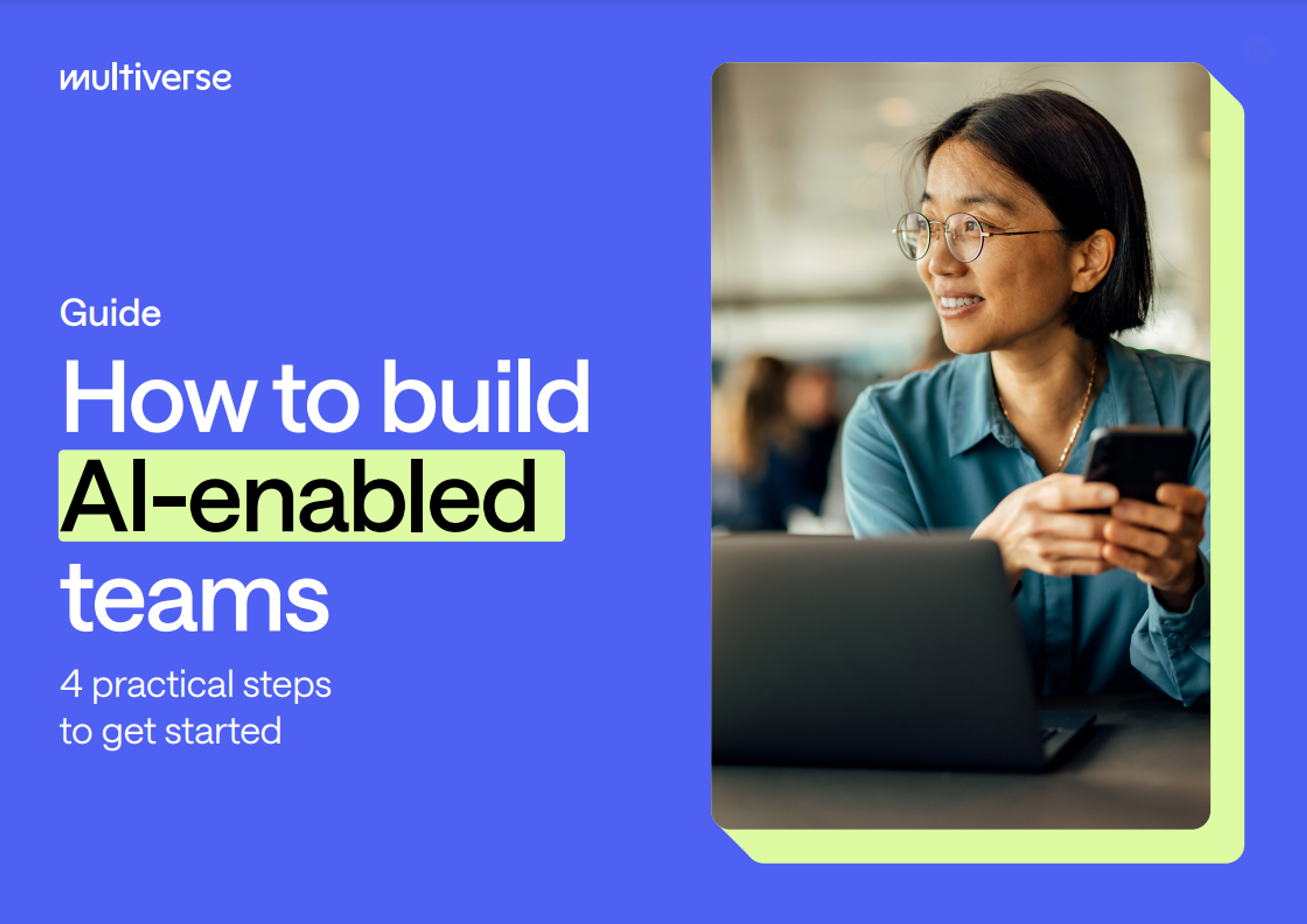Artificial intelligence (AI) in the workplace is on the rise.
Nearly three in four (72%) businesses are using AI, which is up from 50% in previous years, according to McKinsey(opens new window).
Here are 10 key benefits of AI in the workplace and four ways you can access these positives in your business:
10 benefits of AI in the workplace
- New career opportunities: The World Economic Forum(opens new window) (WEF) predicts that by 2027 we’ll see 2.6 million jobs added by AI.
- Revenue increases: Four in five leaders say implementing AI has led to an increase in revenue generation (Multiverse ROI of AI report). About 75% of the value that generative AI (GenAI) could deliver falls across four areas: customer operations, marketing and sales, software engineering and R&D (McKinsey(opens new window)).
- Productivity boosts: Businesses using AI to sort vast amounts of customer and market data are seeing as much as an 80% reduction in data processing time – supporting a 40% improvement in speed to market for new products and services (Accenture(opens new window)).
- Increased GDP: PwC(opens new window) and McKinsey(opens new window) report that global GDP will be 14% higher in 2030 as a direct result of AI – the equivalent of a staggering $15.7 trillion of new value.
- Creating efficiencies: More than 80% of workers surveyed – who use generative AI (GenAI) daily – expect it to make their time at work more efficient in the next 12 months (PwC(opens new window)).
- Business value: 83% of workers think AI skills will help them to drive more value for their employer in the next 12 months (ROI of AI report).
- Greater employee satisfaction: Deloitte(opens new window) reports that, on average, more than half of Millennials (55%) and Gen Z (58%) employees believe GenAI will free up time and improve work/life balance. And half (49%) of all daily GenAI users expect the technology to lead to higher salaries (PwC(opens new window)).
- Increased demand for AI specialists: The WEF(opens new window) expects to see a 40% jump in the number of AI and machine learning specialists. And a 30%-35% rise in demand for roles such as data analysts and scientists or big data specialists.
- Heightened competitive advantage: 68% of senior leaders in financial services and telcos believe that competitive advantage in their industry will depend on who can make the best use of AI (Experian(opens new window)).
- Transforming industries: According to cross-industry research from Accenture(opens new window)company(opens new window) found that the banking (54%) and insurance (48%) industries hold the highest potential for AI impact through automation

4 steps to building AI-enabled teams
4 ways to unlock the benefits of AI in your workforce
Create a future-ready AI skills strategy
Tech investments need to be combined with an AI-enabled workforce to get the most from the technology. But there are several barriers holding businesses back from reaching AI maturity – and technical skills are a big one.
In fact, our ROI of AI: Unlocking AI maturity through workforce skills report found that leaders currently name AI as their most significant skill gap (45%).
That’s because AI and data literacy is an ongoing challenge in the workplace. Half of workers have received less than five hours of AI training. And employees struggle with the basic data skills needed to achieve the full benefits of AI, such as making data more efficient (53%) or analyzing data to make informed data-driven decisions (46%).
Fixing these skills gaps starts with a targeted upskilling strategy. One which equips your teams the most needed AI skills for your business.
These skills may be different across sectors, job titles, roles and functions, and your crafting an effective AI skills strategy needs to first begin with identifying your business opportunities to generate Return On Investment (ROI) from AI.
Define measurable goals
Measurement should sit at the heart of your strategy.
Setting a benchmark for measuring success with AI also helps to ensure all training ladders up to your business’s wider picture. Do your customer service executives need training in how to automate manual processes? If one of your goals is to improve the speed of customer responses, then the answer could be yes.
However, measurement is only as successful as the strength of the strategy and goals set in the first place. Only then can results truly be measured to anticipate hurdles and uncover opportunities.
Give teams the tools and training they need to succeed
Once you’ve got a solid skills strategy in place, implementing tools and training is the next step.
When we think of tools, it’s easy to go straight to technology. But, when it comes to unlocking the benefits of AI in your workforce, providing safe guardrails to innovate is vital. That means creating clear policies, guidelines or even Centres of Excellence with best practice examples.
Today, just 45% of employees have received formal AI training provided by their employer. So, it’s likely workers will struggle to assess whether their actions are aligned with the company without policies or broader best practice – creating potential risks for the business.
It’s about ensuring policies are being adhered to, with people not only accountable for how they’re using AI, but also proud of it. That means fostering a positive culture around AI in the workplace, with the integration of technologies into operations, processes, and employee interactions.
Enable new career opportunities for employees through AI skills
Businesses need to build expertise in AI, fast, but formal AI training opportunities remain in short supply.
We’ve found that most workers learn AI skills informally by experimenting with ChatGPT (61%) or learning on the job (59%). And half (51%) have received fewer than five hours of training on AI.
Workers are largely fending for themselves when it comes to using – and learning how to use – AI. This presents challenges for both the worker and the business, from struggling to assess knowledge gaps to unlocking efficient processes.
According to our ROI of AI report, businesses are aware of the gaps and leaders are looking to invest in data upskilling in 2025. Half of the organizations that have identified skills gaps as a key barrier to full implementation of AI plan on upskilling employees through long-term external AI training programmes (56%) and ad-hoc/short-term external AI training programmes (50%).
There’s a clear opportunity for businesses to upskill employees through AI training and reskilling employees into AI specialist roles. Not only could this help accelerate their career progression, but it may increase capabilities to spot opportunities for the business.




